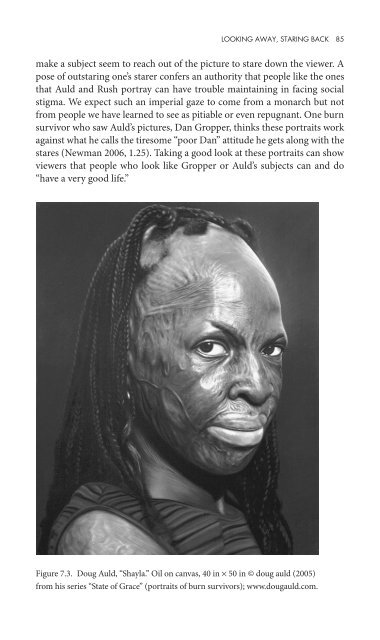Staring how we look sobre la mirada.pdf - artecolonial
Staring how we look sobre la mirada.pdf - artecolonial
Staring how we look sobre la mirada.pdf - artecolonial
You also want an ePaper? Increase the reach of your titles
YUMPU automatically turns print PDFs into web optimized ePapers that Google loves.
38 WHAT IS STARING?<br />
Furthermore, social scientists agree that disability is a visual cue for lo<strong>we</strong>r<br />
expectations and discomfort for those who identify as nondisabled. Discomfort<br />
comes in part from the social illegibility of the disabled body. The<br />
social rituals in which <strong>we</strong> accord one another recognition depend on accurate<br />
reading of bodily and gestural cues. Unpredictable or indecipherable<br />
cues create anxiety. It is not that disability itself creates unease, but rather<br />
people’s inability to read such cues disrupts the expected, routine nature of<br />
social re<strong>la</strong>tions.<br />
We are exquisitely sensitive to the nuances of meaning encoded in appearance<br />
variations and to the rituals of social encounter that tell us who <strong>we</strong><br />
are in re<strong>la</strong>tion to others. Think of the hint implied in a wink, the moral equation<br />
of good posture and upstanding citizenship, the gendered connotations<br />
of sitting with one’s legs spread apart. 7 All these meanings rely on a certain<br />
bodily stability, on a re<strong>la</strong>tively narrow range of variations that <strong>we</strong> learn to<br />
read with precision. Someone permanently seated in a wheelchair, <strong>how</strong>ever,<br />
confounds the usual interpretive <strong>we</strong>b of social significances clustering<br />
around what <strong>we</strong> might call the postural arrangement of bodies. In another<br />
example, height re<strong>la</strong>tions express a literal hierarchy. The dais and the pulpit<br />
ceremonially raise kings and clergy above lesser beings; the arrangement of<br />
gender pairings almost always yields a man made tall by a shorter woman.<br />
The uprights among us usually do not know <strong>how</strong> to read or what to make<br />
of a wheelchair user or the person of small stature who is waist-high in the<br />
world. 8<br />
Moreover, moving and seeing in expected and ordinary ways are central<br />
to our sense of who <strong>we</strong> are in the modern world. In all of human history until<br />
the first third of the nineteenth century, <strong>we</strong> moved ourselves and our products<br />
by foot, boat, or draft animal. Within just one hundred years, trains,<br />
cars, and airp<strong>la</strong>nes along with the material public world of streets, stairs, and<br />
runways they created expanded exponentially our capacity to move across<br />
space and time. Simi<strong>la</strong>rly machines such as the printing press, the camera,<br />
the x-ray machine, the microscope, the telescope, and the computer extended<br />
our eye from the immediate surroundings to the previously hidden interior<br />
of the body, the edge of the universe, the bottoms of the sea, or any p<strong>la</strong>ce<br />
on earth. These two actions merge in what Anne Friedberg (1993) calls the<br />
“mobilized gaze,” a skill required by modern life and its built environment.<br />
The ability to deftly use machines of mobility and vision furnishes access to<br />
resources and public spaces. Such skills are forms of cultural capital often<br />
unavai<strong>la</strong>ble to people with certain kinds of disabilities. All too often, social<br />
and economic resources and the built environment are inaccessible to many<br />
disabled people, excluding them from the privileges of being ordinary.<br />
If staring attempts to make sense of the unexpected, the disabled body<br />
might be the exemp<strong>la</strong>ry form of the unforeseen. We gawk when presented


